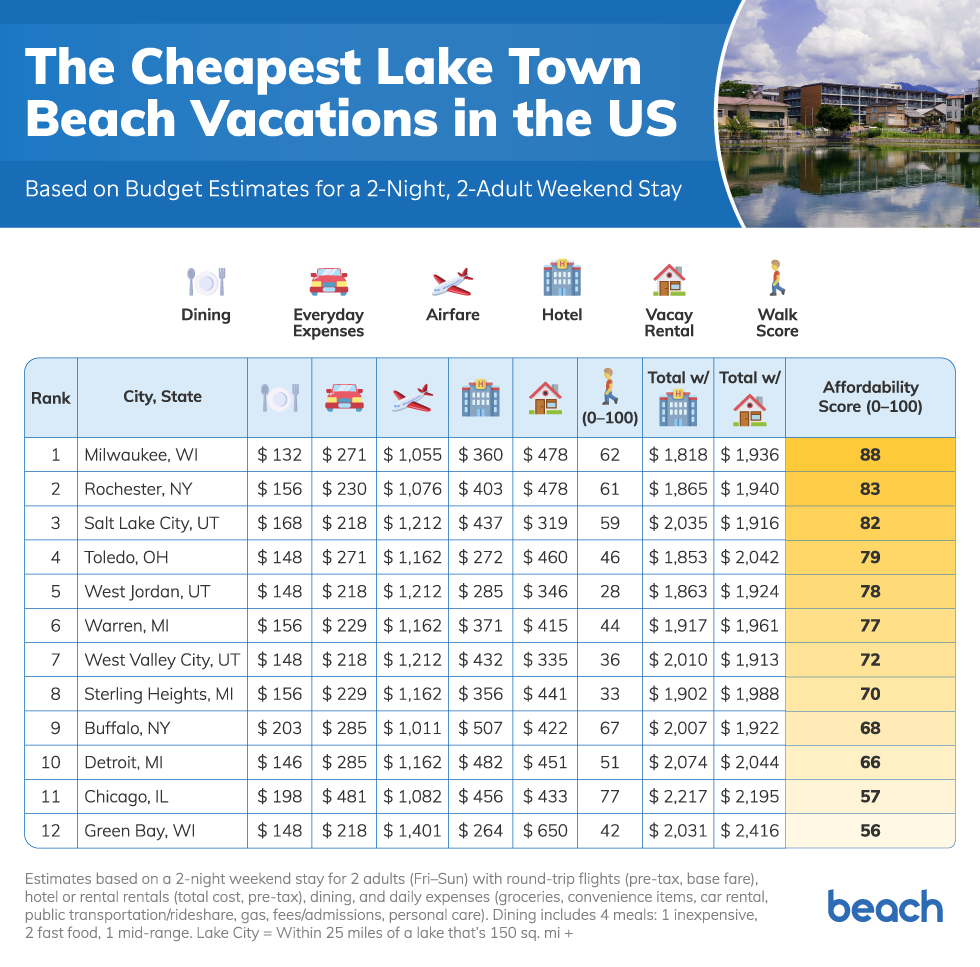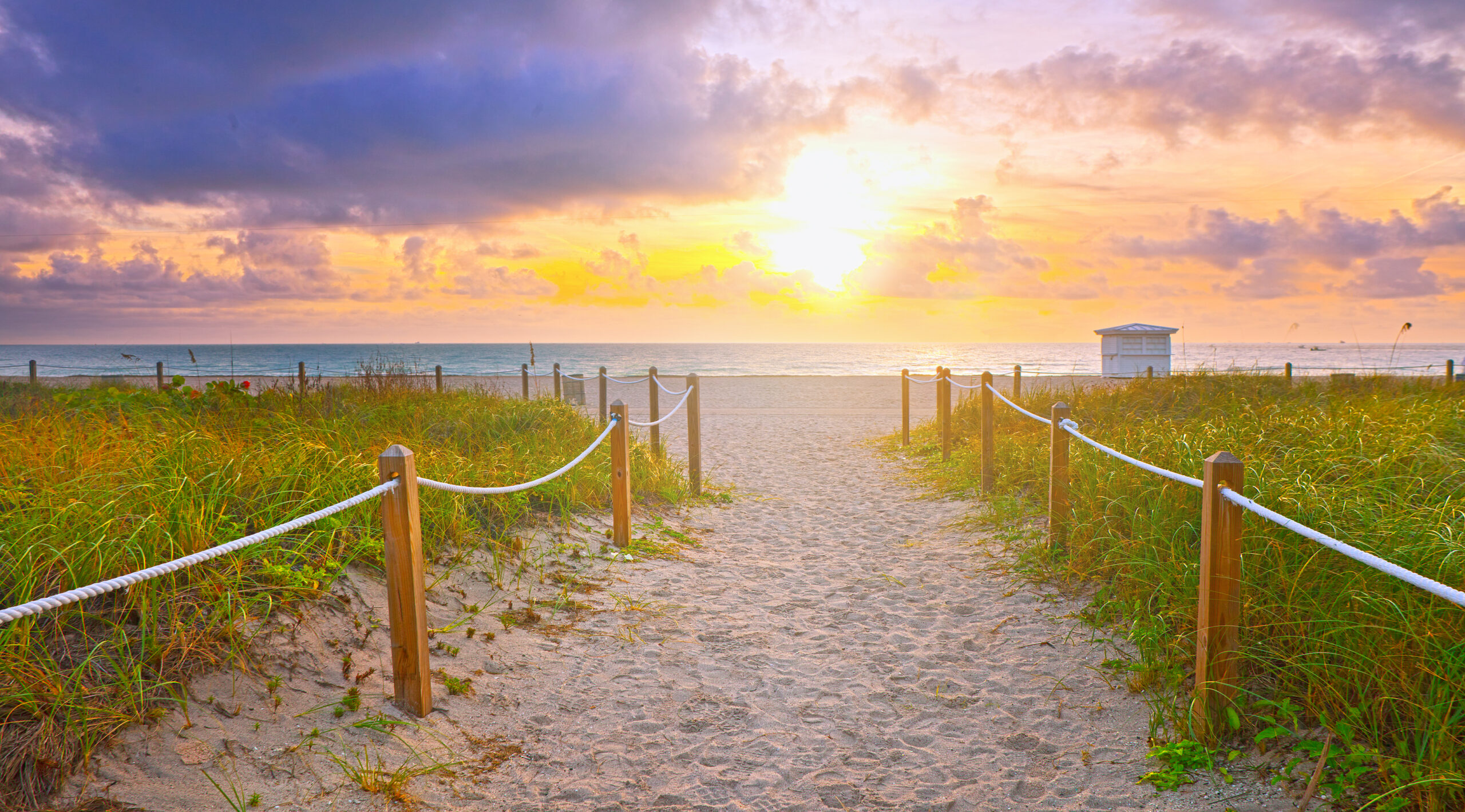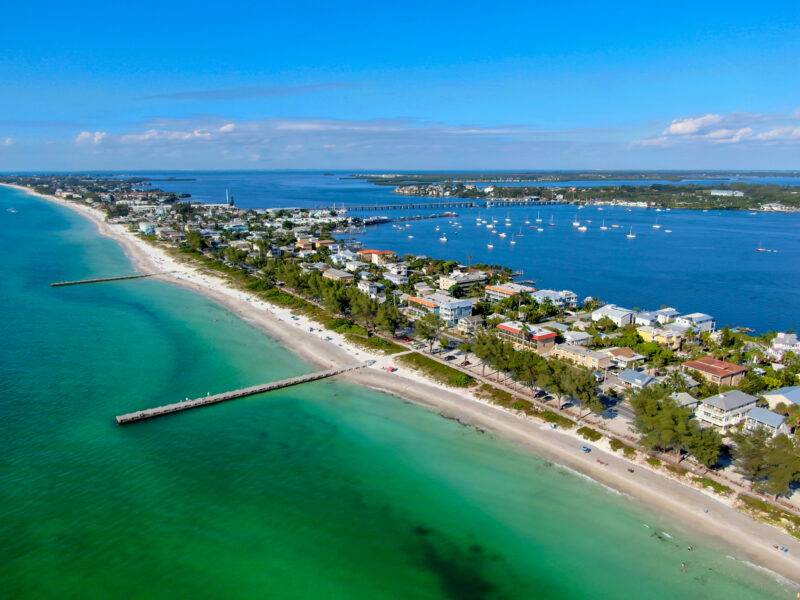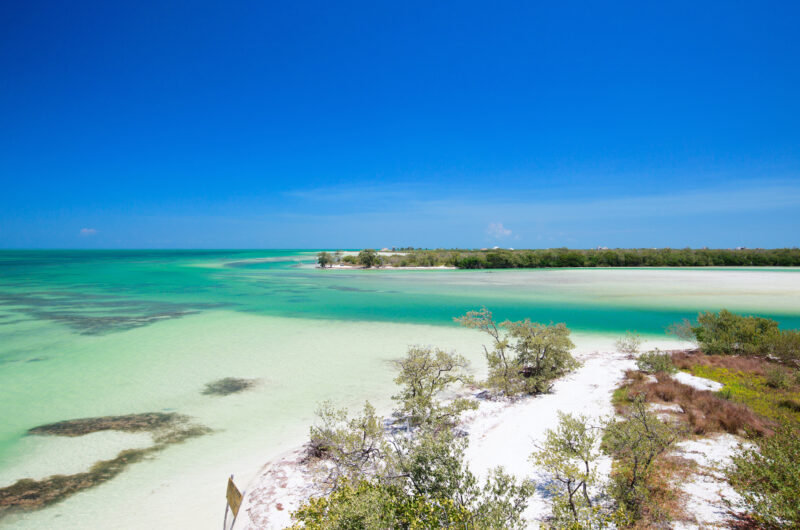It might seem like finding an affordable beach vacation is a myth. However, there are plenty of coastal destinations where sand, sun, fun, and affordability exist harmoniously. They may just not be on your radar! So, we at Beach.com analyzed over 32 million flight records, over 90,000 vacation rentals, and just about every other travel cost factor of the 100 largest U.S. cities within 25 miles of a beach. We found the American beach towns that offer cheap beach vacations, including some surprisingly affordable beaches in Florida.
Our expansive analysis considers both hotel and vacation rental lodging, dining, transportation, everyday expenses, and walkability. We went further, adjusting for seasonal price fluctuations to ensure the destinations in our analysis aren’t just affordable at certain times of the year, but are reliably cheap year-round. Read on for your go-to data-backed guide on all the cheap beach vacations in the U.S., no matter where your journey starts!
Key Takeaways
- Pasadena, Texas, ranks #1 overall as the most affordable beach vacation spot.
- Baltimore, Maryland, is the most affordable large city beach vacation.
- Milwaukee, Wisconsin, is the most affordable lake town beach vacation.
- Long Beach, California, has the cheapest round-trip airfare, averaging $902 for 2 tickets.
- Tampa, Florida, has the cheapest vacation rental rates, averaging $314 for a 2-night, 2-adult stay.
Small US Cities With Affordable Beach Vacations
Pasadena, Texas, is the #1 most affordable beach town vacation destination in the U.S., not just among small cities, but of all the cities in our analysis. What propels Pasadena to #1 is having the second-most affordable airfare, hotel, and vacation rental rates out of the entire analysis. The city doesn’t score high for walkability or everyday expenses. However, the amount you can save on airfare and accommodations can make up for this.
Hialeah, Florida, is the second-most inexpensive beach vacation destination overall and in the small city group. With an average total of $343 for a 2-night, 2-person weekend stay, it is an affordable vacation rental hotspot. It has the cheapest vacation rentals of all the small cities in our analysis. It also has the tenth-best walkability of all our small towns. Hialeah is a perfect beach destination that puts you right next to Miami without the exorbitant cost.
Pearland, Texas, is also one of the best small cities for cheap beach vacations. In our analysis, it had the lowest average dining costs, estimated at $111 for a 2-person weekend trip. It ties for the cheapest flights in our small city index at a total estimated cost of $908 for a 2-ticket round-trip flight. The city tied for the second-cheapest airfare of all cities, big and small. Pearland is quite affordable across many of our metrics. When combined, Pearland has the lowest estimated total trip cost of $1,644 for a 2-person weekend vacation rental stay of all analyzed cities.
Tucked near the southern edge of Texas, Brownsville is also among the country’s cheap beach vacations. The city leads study-wide in the everyday expense category, with an estimated total of $215. You won’t find a cheaper option for all those incidental trip expenses like rideshare, gas, and groceries. As you probably already know, incidental expenses, despite their name, can add up to a huge chunk of any vacation budget. Brownsville is your best bet for keeping those everyday expenses low on your coastal escape.
The average cost of daily expenses, including meals, activities, and incidentals, is $243 for a two-person weekend beach trip. While it’s rarely the most expensive part of a beach getaway, it’s one of the few budget items travelers can have more control over. Another way to reduce everyday expenses is to find a destination with great walkability. Walkability not only cuts down on rideshare or other public transportation costs, but it can also help you avoid renting a car. For cheap beach vacations in a small city with great walkability, look no further than Cambridge, Massachusetts.
For the cheapest beach city hotel rates, there’s none cheaper than League City, Texas. It averages a total of $227 for a 2-night, 2-adult weekend stay. The city also ties with Pearland and Pasadena, Texas, for the cheapest small-city airfare at $908 for 2 round-trip tickets. Added up, League City offers the most affordable total trip cost for a weekend beach vacation getaway at a hotel. Our analysis estimates this cost to be $1,541.
Large US Cities With Affordable Beach Vacations
Finding an affordable beach vacation doesn’t mean having to skip out on top metro destinations. A big city doesn’t usually equate with affordability. Still, we managed to find plenty of cheap beach vacations you can take in the U.S., where the skyline meets the surf.
Baltimore, Maryland, ranks #1 in our large city index for a destination with the cheapest beaches to visit. For a 2-person weekend getaway, it has the second-cheapest dining costs ($154). It also has the fourth-cheapest airfare ($1,003) and hotel rates ($363). All tallied up, we estimate a 2-person weekend getaway at a hotel to run $1817 in Baltimore. It is the second-most affordable total estimated cost for a two-night, two-person hotel stay.
With so many small cities in the Houston metropolitan area ranking high in affordability, unsurprisingly, Houston itself lands #2 in our cheap large city beach holidays index. At $160, it has the third-cheapest dining costs, and at $348 for 2 nights, the third-cheapest hotel costs. It boasts the second-cheapest airfare at $908 for 2 round-trip tickets. It also has the second-cheapest vacation rental rates, averaging $333 for 2 nights. In total, our estimates put Houston as the lowest total estimated cost for a 2-person weekend hotel ($1,749) or vacation rental stay ($1,734). No matter which route you choose, it will give you one of the best cheap beach vacations in the country.
Coming in at #3 is Oakland, California, even though it doesn’t rank #1 for any of the individual cost metrics. Still, the city has relatively affordable costs across the board. It also has the third-cheapest estimated airfare (averaging $914 for 2 round-trip tickets) of all the large cities in our study. If you’re looking for that California beach vacation that has all the big city offerings without breaking the bank, look no further than Oakland.
Or look a little further along the coast at Long Beach, California. This city ranks among the top cheap beach vacations to take. Coming in at #4 overall in our large city index, and with 2 round-trip tickets averaging $902, it has the #1 most affordable airfare. The city doesn’t score very high for affordable hotel and vacation rental rates. However, its vastly cheaper airfare can help offset some of those costs.
Rounding out California with one more honorable mention, we look to San Francisco. This city has the greatest walkability of all the large beachside cities in our study. It’s far from #1 on any other cost metric, but walkability is no small win. A city like San Francisco has great walk scores by California and even U.S. standards. Walkability cuts down on ridesharing, car rentals, and gas costs. The city has the fifth most expensive estimated everyday expenses (which includes ridesharing, car rentals, and gas) of the entire analysis. So if you are a traveler who can minimize those costs due to great walkability, then San Francisco can be a uniquely more affordable California beach vacation.
Next in our rankings, we spotlight Tampa, Florida. Our analysis recognizes this city for having the cheapest vacation rental rates in our big city beach index. It’ll run you around $314 for a two-night, two-adult stay. The city ranks #7 overall in the big city index. It also ranks #5 for the most affordable everyday expenses ($295) and airfare ($1,005). Combined, we estimate Tampa has the second-cheapest total estimated cost for a vacation rental stay.
Rounding out our group of large beach cities is Corpus Christi, Texas. For a 2-adult, weekend stay, it has the cheapest total estimated dining costs ($146). It also has the cheapest total everyday expenses ($267), and even total hotel rates ($322). The city would land higher in our results if it were not for the pricier 2-ticket, round-trip airfare ($1,266) and lack of walkability. It ranks #8 overall in our index and ranks fairly well for the total estimated trip cost of a weekend vacation rental stay ($2,078).
US Lake Towns With Affordable Beach Vacations

Lake beaches may not be the first destination that comes to mind when planning a beachside escape. However, you would be amiss to overlook some great lakeside towns. Not only will you get your sand and sun, but these locations can offer a quieter escape as well. If you’re looking for cheap places to travel in the U.S. with beaches, then a sandy lake town is an excellent way to go.
Milwaukee, Wisconsin, tops the charts in our affordable lake town beaches index. The city boasts the #1 most affordable lakeside dining experience. Our analysis estimates that eating out will run you around $132 for 2 people on a weekend stay. It also ranks well across the expense board. It’s the city with the lowest estimated total trip cost for a weekend hotel stay at $1,818. With plenty of sandy beach access options up and down Lake Michigan, Milwaukee should be your #1 consideration when looking for cheap beach vacations on a lake.
Staying with Wisconsin, we go to Green Bay next. While the city places last in our lakeside affordability index, it does have the cheapest hotel rates in this category overall. We estimate a hotel will run you an average total of $264 for a 2-person, weekend stay. Higher airfare, vacation rental rates, and a Packers home game can add to the cost of a trip to Green Bay. However, it’s still an excellent option if you’re looking for a cheaper beach weekend getaway.
Rounding out our lake index, we have two honorable mentions. Buffalo, New York, will give you the best bang for your buck in airfare. We estimate that 2 round-trip tickets will run an average of $1,011. Then, no other city in our lake index has a walk score like Chicago, Illinois, does. Both of these cities are a bit lower in affordability overall. However, if airfare or minimizing local transportation costs is top of mind for you while you plan, then both of these cities offer cheap beach trips near a lake.
Find Your Affordable Beach Escape
Contrary to what might seem naturally assumable, the beach does not have to be expensive. No matter what kind of traveler you are, a minimalist solo nomad, a budget-conscious family, or a pair of romantic adventurers — Beach.com gets it. We’re here to help you find the perfect beach vacation for your travel style and budget.
Want to make some waves together? At Beach.com, our passion for beaches is more than just about travel. We’re highly committed to preserving and protecting the very destinations we love to talk about. That’s why we organize beach cleanups, and we’re calling on our fellow beach aficionados to join us. If protecting our coastal areas is as important to you as it is to us, consider becoming a Cleanup Captain to help steer us to the better, cleaner, healthier coastlines of tomorrow.
Sources and Methodology
Affordability Index: Our findings are based on an analysis of the 100 largest U.S. cities within 25 miles of a beach. To find cheap beach vacations in the U.S., we created our index to balance various common travel expenses while accounting for seasonal price fluctuations. The travel costs for each city were compared to the national average. We weighted costs based on their relative importance and share of cost to overall trip expenses.
Travel expenses can vary dramatically depending on the time of year, especially for accommodations and airfare. To include price volatility in our analysis, we calculated the standard deviation of airfare, hotel, and vacation rental prices for each city across three quarters. Then, we created a relative volatility score, which was directly baked into our algorithm. Cities with greater price fluctuations receive lower affordability scores due to pricing inconsistency. Price volatility can make budgeting for travel more difficult.
For the fairest analysis, we organized the cities on our list into three categories, ranking cities only within their respective category. Those categories are Small Cities (Population <250,000), Large Cities (Population >250,000), and Lake Cities (non-coastal cities). Furthermore, only cities within 25 miles of a lake that is at least 150 square miles in size or larger were included.
Our index includes six key cost factors with the following weights:
- Dining Costs (Weekend for 2 Adults): 15%
- Everyday Expenses (Weekend Groceries/Convenience Food, Vehicle Rental, Public Transportation/Rideshare, Fees/Admissions, Personal Care Products/Services, and Gas for 2 Adults): 15%
- Airfare (Round-trip for 2 Adults): 25%
- Hotel Rates (2 Nights for 2 Adults): 15%
- Vacation Rental Rates (2 Nights for 2 Adults): 15%
- Walkability: 15%
- Price Volatility: Volatility scores were created based on the standard deviation of airfare, hotel, and vacation rental prices. These scores were then used to create an adjusted cost metric for accommodation and airfare, giving greater penalties to cities with more inconsistent pricing. This adjusted metric was only used in the affordability index, and all estimated costs displayed in the table and copy are in real, unadjusted averages.
Dining Costs: To estimate dining costs in each city, we used the Cost of Living database by Numbeo. We gathered cost estimates for the following: (1) a meal for one at an inexpensive restaurant, (2) a three-course meal for two people at a mid-range restaurant, and (3) a combo meal for one at a fast food restaurant. All data was collected on 3/24/25.
For cities on Numbeo that did not have a minimum of 30 contributors within the past 18 months, we used the US-wide dining cost estimates. We then applied regional price parities (RPP) from the Bureau of Economic Analysis (BEA) for each city’s metropolitan statistical area (MSA). This allowed us to avoid any low contributor sample sizes with a standardized, third-party validated (official government data) dining cost estimate.
Total dining costs were calculated for a weekend trip (Fri-Sun) with a party of two. Meals include one inexpensive restaurant meal, two fast food combo meals, and one mid-range three-course meal. All other food costs, including groceries, convenience store snacks, and other miscellaneous food expenses, are included in the everyday trip expenses category.
Everyday Trip Expenses: To estimate incidental expenses while on vacation for each of the cities in our analysis, we used the Bureau of Labor Statistics (BLS) Consumer Expenditure Survey (CE), Table 2400: Population size of area of residence: Annual expenditure means, shares, standard errors, and relative standard errors, for 2023. We assembled a basket of travel goods/services from individual line items from this latest BLS CE. This “basket” includes vehicle rentals, public transportation, entertainment fees and admissions, personal care products and services, gasoline, groceries and convenience items.
We used estimates from the Consumer Expenditure Survey (CE) broken down by population size of area and matched the cities in our list by population to the CE population brackets. Then, to create even better estimates, we applied regional price parities (RPP) from the Bureau of Economic Analysis (BEA) at the metropolitan statistical area (MSA) level to scale estimates at the local level.
The Consumer Expenditure Survey (CE) estimates costs per consumer unit. However, many consumer units in the U.S. do not participate in certain activities like travel or public transportation. For a more accurate estimate of incidental expenses, we scaled the figures by the latest estimates of the number of Americans who engage in these activities. Traveling consumer units were scaled by the percentage of U.S. travelers, as reported by a Statista survey. Public transport consumer units were scaled by the rate of U.S. consumers who use public transportation and ridesharing, according to Statista.
We used an estimate of seven out-of-town trips per consumer unit per year to estimate daily expenses while out of town from the Consumer Expenditure Survey (CE) for certain line items that cannot be broken down to a daily level. This figure was estimated by combining the number of person-trips for leisure and business purposes from the US Travel Association, divided by the total U.S. population. Entertainment fees and admissions were broken down at the weekly level. We used the assumption that a consumer unit spends on fees and admission once per week in a year.
Flights: To estimate average round-trip airfare for each city, we analyzed over 32 million flight records from the entire Airline Origin and Destination Survey (DB1B) from the Bureau of Transportation Statistics (BTS). We analyzed records for the last three quarters of 2024. This database is a sample of all airline ticket transactions in the U.S. We aggregated average airfare from all connecting origin cities in the U.S. to each destination for each quarter in 2024.
The result of our analysis is an airfare estimate that identifies beach destination cities that are cheapest to fly into, regardless of where you’re flying from in the U.S. All flight transactions with airfare <$30 or >$10,000 per ticket were removed prior to our analysis to control for outliers and ticket transactions reporting only taxes and fees, but not the actual base fare.
Hotels: On 3/27/25, we used hotel search on Google to estimate the average nightly rate for hotels by city. We gathered the price range estimates for 2, 3, and 4-star hotels from Google’s “What you’ll pay” section. This section provides monthly rate estimates by month for each city and hotel star rating combination. Estimates were attained for June, September, and December 2025 for two guests. We then took the midpoint of the cheapest and most expensive nightly rate across all hotel star ratings for each city per quarter to use in our analysis.
Vacation Rentals: On 3/30/35, we analyzed data on over 90,000 vacation rental listings (900 per city) to estimate nightly rates. For a weekend stay for two adult guests in June, September, and December, 300 listings per city + month were analyzed. Only listings offering “entire home” rentals were included in the analysis. All rates are total rates before taxes, averaged by city to estimate vacation rental costs.
Walkability: On 3/28/25, we gathered the Walk Scores for each city on our list from Walk Score. City walkability can greatly reduce the need for public transportation, ridesharing, or car rentals. Scores range from 0 to 100, with 100 equalling the greatest walkability.
Price Volatility: To account for price variability in airfare, hotels, and vacation rental costs, we calculated the standard deviation of rates across three quarters. Then we measured how much prices fluctuate over time. We adjusted estimated costs for airfare, hotel, and vacation rental rates by creating a relative volatility score. We took the standard deviations and divided them by US-wide averages. Using a scaling factor of .5, we induced the resulting volatility into the estimated costs. This figure was used in the final index computation to account for pricing volatility. However, expenses reported in the tables and throughout the report are in real, unadjusted averages.
Fair Use
When using this data and research, please attribute by linking to this study and citing Beach.com.



